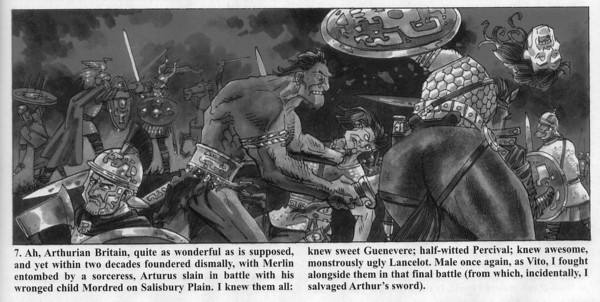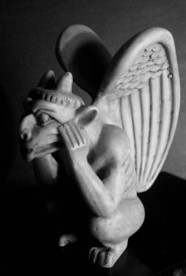Most of the action in Black Dossier takes place in 1958, and involves the theft of the 'Black Dossier' by Allan Quatermain and Mina Murray, and their pursuit by various agents of British Intelligence. Aside from allowing Moore to link 1984 and Frank Richards's 'Greyfriars' stories with almost every British spy story you care to think of, this serves as a framing sequence for the Dossier itself.
The eponymous Dossier consists of an assortment of documents which, viewed in their entirety, detail the history of the League over the centuries, and indeed place it in a broader historical context, just as the 'New Traveller's Almanac' in League Volume II had mapped out the geography of the world in which League is set. The documents include part of a lost historical play by Shakespeare entitled Faerie's Fortunes Founded, an account by Bertie Wooster of the manifestation at his Aunt Dahlia's home Brinkley Court of Lovecraft's Elder Gods, and an extract from a beat novel by Sal Paradyse featuring characters based on Mina, Allan, and the grandchildren of Fu Manchu and Professor Moriarty.
The chronological backbone of the series is laid out in the eighteen-page 'Life of Orlando', presented in the form of a 1950s boy's adventure comic. That's part of the charm and the brilliance of this book -- it's a triumph even as an object, with each pastiche looking absolutely perfect, whether resembling a yellowed paperback or a Tijuana bible. Anyway, Moore merges the different Orlandos that have been written over the years into one immortal character of mutable gender and -- it would seem -- species, and uses him to mark out the major events in the history of the world of The League of Extraordinary Gentlemen, such as, for example, the brief flickering candle of Camelot.
 1958, the year in which Black Dossier is set, was also the year in which the Candle in the Wind, the fourth part of T.H. White's Arthurian epic The Once and Future King, saw print, detailing the destruction of the dream that was Camelot. It can hardly be a coincidence then that in describing Arthurian Britain, Orlando refers to 'awesome, monstrously ugly Lancelot', who you can see here, hacking his way across the battlefield.
1958, the year in which Black Dossier is set, was also the year in which the Candle in the Wind, the fourth part of T.H. White's Arthurian epic The Once and Future King, saw print, detailing the destruction of the dream that was Camelot. It can hardly be a coincidence then that in describing Arthurian Britain, Orlando refers to 'awesome, monstrously ugly Lancelot', who you can see here, hacking his way across the battlefield.White's Lancelot, introduced in 1940's The Ill-Made Knight, is as brave and mighty as any other take on the character, but unique among Lancelots in being spectacularly ugly -- White describes him as ape-like. There's no doubt then that this is meant to be White's take on the hero, not least because, as Keith Kole rightly observes on Jess Nevin's annotations site, there is a marked similarity between Kevin O'Neill's depictions of Lancelot, Caliban, and Edward Hyde.
On top of that, White's Lancelot is a sadist. It's not just that he's merely good at beating people up and killing them; he actively enjoys doing so and takes pleasure in inflicting pain on others. He's not just monstrously ugly, as Orlando opines, he is -- in effect -- himself a monster, slaughtering in the service of his queen. But that shouldn't surprise you, really, considering yesterday's observations on another rather more contemporary sadist.
I think it's fair to say that Lancelot's a far more attractive character than Bond, though. He may be a sadist, but he knows it, and is horrified by it. Deeply good, rather than ruthlessly amoral, his whole life is dedicated to controlling the beast that he is, to harnessing his monstrous tendencies so that his extraordinary abilities can be used for good, rather than evil.
It's rather tempting to consider Lancelot as a sort of proto-Hyde figure, considering not just his appearance but how Edward Hyde's character developed over the first two volumes of League.
It's also worth noting in this respect that O'Neill depicts Lancelot as looking suspiciously reminiscent of Sláine, the Celtic hero of 2000AD. Look at his armlet, and at that wide and ornate metal belt, and then note that that's pretty much all he's wearing: everyone else is wearing generic Celtic armour. Why? Well, the implication must be that that like Sláine and Cúchulainn, the Irish hero upon whom Sláine is largely based, Moore and O'Neill's Lancelot is warped, prone to berserker furies that transform him into a creature more like a beast than a man, and utterly invincible in battle. Echoes of Hyde again, methinks...
I know, it's a lot to get from just one panel, isn't it? That's Alan Moore for you, though. And if you turn the page you'll see that O'Neill's depiction of Beowulf rather spectacularly echoes his Lancelot; this Beowulf wears a similar armlet on his right arm, and a wide and ornate metal belt and not much else. With his ragged mane and his broad grin he looks more than a little like Sláine as he used to be drawn by Mike McMahon, back when O'Neill and Moore were still working for 2000AD. Is Beowulf a berserker too, then? Possibly -- after all, Orlando observes that he's 'still not really sure what Beowulf was, exactly.' He's right to wonder, and if you watch the film in the cinema at the moment, you'll be hard pressed not to agree with Grendel's mother that beneath his heroic glamour, Beowulf is a monster just as much as her son.
I even wonder whether we're meant to see parallels with Orlando's description of Ajax as 'a confused brute', or of Mina's reference to Bulldog Drummond as 'a big ape', but if I were to get started on that, I'd never talk about anything else.
Moore tomorrow so. Same League time, same League channel.

No comments:
Post a Comment